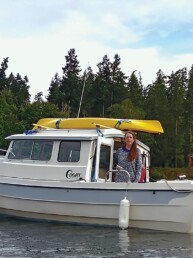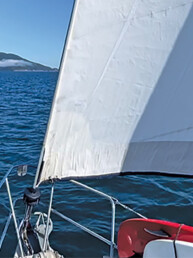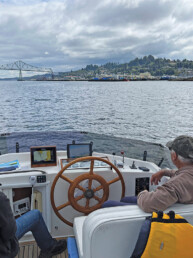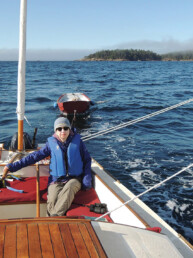Writing about our rough crossing of Hecate Strait isn’t something that comes easily—it’s actually a memory I’d rather not relive.
Learning from your mistakes is an important trait of successful sailors, though, and the passage of time is erasing the worst bits. It seems that the memory of a difficult experience and the assurance that it eventually passed is what enables sailors to continue doing things that aren’t always fun.
My wife, Natalie, and I had plenty of tough sailing in the Pacific Northwest over the years, but our crossing of Hecate Strait was on another level entirely. Hecate Strait isn’t like other bodies of water. It has all the ingredients for rough, closely spaced waves: shallow waters, currents (both in the Strait itself and the exiting sounds adjacent to it), ocean swell entering in a direction contrary to wind waves, sharp headlands, and underwater seamounts created by the glacial topography.
Hecate lies between Haida Gwaii and the central and northern coasts of British Columbia; and traversing its 60-to-90 mile width is the main way to get to Haida Gwaii. The other option is crossing Queen Charlotte Sound directly from the vicinity of Port Hardy or Cape Caution, but that’s significantly longer. As a point of reference, Hecate is six times wider than the Strait of Juan de Fuca and about twice as long.

Besides the topographical challenges, the Strait funnels wind from either the north or south, with 150 nautical miles of fetch for waves to build. The resulting waves are nothing like ocean waves—in full gales the waves commonly build to 5 meters (15 feet) at 7 seconds (which cuts the wave period of ocean swell roughly in half), and this still understates how steep they are.
On June 15, we were at the south end of Haida Gwaii near Rose Harbor, ready to cross back to mainland British Columbia after two gorgeous weeks of cruising. We had enjoyed the beauty, but were anxious to move on. Raging southerlies had swept through every two to three days for most of June, requiring us to sit in anchorages with rain so heavy we were often boat-bound.
The sound was what got to us the most. Being in 35 knots creates a strident cacophony. Wind howled through the rigging, creaking sounds emanated throughout the boat and bulkheads, breaking waves roared behind us; and then there was the percussive boom of a wave hitting the hull.
The forecast had finally switched from southerlies to northerlies, which was just what we needed for a downwind run. But the predicted winds were a bit high — northwest at 20-30 knots for our target departure day, building to northwest 30-35 on the three days after that. At that point, we knew we had to go or wait another four to five days.
From our guidebooks and charts we knew Hecate’s reputation, but failed to fully appreciate its potential. The next morning, we woke at 4 a.m. and weighed anchor in the dark, preparing for the 18-plus hour crossing. There was no wind yet, so we motored offshore for an hour and then raised full sails in 10 knots from the northwest. As the morning progressed and the wind built, we reefed the main, reefed the roller furling 135% genoa, reefed the main again, furled the genoa, and then deployed our staysail.

Finally, as the wind built to 30-35 knots and the double-reefed main was making boat handling squirrelly, we took down the main and flew under staysail alone, still making 5.5 to 6 knots. It was bit under hull speed, but knowing we had a long day in store, we preferred to go too slow rather than too fast. At this point, it was all about energy conservation.
The waves at 20-25 knots got large and powerfully pushed our C&C Landfall 38, Violet Hour, around; but not beyond what we’d seen before in other places. At 30-35 knots in the middle of the strait, the waves took on a character distinctly different from our prior experience. I estimated 7-14 feet at 7 seconds (and the BC ocean buoy for the Strait later corroborated this). They were closely spaced and coming from multiple directions. The sight, sound, and feel of being in these big winds and waves was a departure from of our previous sailing experience, with radical spikes in stress, discomfort, and unpredictability.
Every couple sets, waves broke at the tops, rolling into a green and white churn that roared towards our stern. If we didn’t hand steer precisely and forcefully through the breakers, the crescendo of water tended to toss our stern quarter forward and round us up. Sailing beam-on to waves like these wouldn’t be good, so we strenuously hand steered for over 12 hours, pushing hard to get the bow down as a breaker approached, and heading back up to course in the troughs and smaller waves.

In terms of sight, I was constantly switching my gaze between the waves and the instrument displaying true wind angle and boat speed. But mostly, I was sailing by looking back over my shoulder, which was necessary to keep a very close watch on waves approaching our stern. The breaking ones approached quickly and erratically. And there was little point in looking ahead, because we couldn’t see over the wave tops anyway. Periodically at the top of a wave, I scanned for traffic. There was none, but I was filled with anxiety knowing that a log or debris would be hopeless to spot.
The tactile sensation of being in these waves was an exercise in constantly bracing our bodies against the tossing movement of the boat. Even though we were sailing downwind, we were rolling sharply as the waves picked up our stern and pushed it forward. Going into the cabin for a few minutes for a change of clothes was positively exhausting, and we minimized movement as much as possible. In the cockpit we wedged ourselves into position, trying to find comfort in the same two to three places for hours at a time.
The sound was what got to us the most. Being in 35 knots creates a strident cacophony. Wind howled through the rigging, creaking sounds emanated throughout the boat and bulkheads, breaking waves roared behind us; and then there was the percussive boom of a wave hitting the hull. The noise got on our nerves after a few hours, and the best relief we got was listening to music with noise blocking headphones.
All the while, fears ran through my head. What if we couldn’t make the harbor we were aiming for and got swept into the southerly point of the sound? The coast there juts out into a long rocky promontory, a lee shore. I wasn’t sure how successfully we could sail upwind in these waves if we had to. And what was that mysterious knocking sound coming from below the cockpit floor every 10-15 seconds? It sounded like the rudder getting pushed up by waves, but also could’ve been a stowed container knocking into the hull.
Of course, things got worse before they got better.
Around 3 p.m. the waves had built more and I gave up on the autopilot once and for all. The biggest waves would come up to our stern, build into growling breakers, and then smack our stern down the wave. Of course, I tried to anticipate these, steering down them before they could have their way with the boat, but sometimes they caught me unprepared. One breaker slammed into the stern quarter and dumped gallons of cold seawater into the cockpit, soaking my pants and shoes. Water sloshed around the cockpit, slowly draining.
It was an immense relief when we finally managed to reach St. John Harbor around 11 p.m. in fading light that was just barely enough to dodge the dozens of logs in the water that had gathered along a tide line in the sound. We’d sailed 104 nautical miles in the worst conditions we’d ever seen, and fell straight asleep, too exhausted to do anything more. Despite regretting our decision to leave on a borderline forecast, we learned a lot from this experience. Since then, we’ve upgraded our autopilot, learned to use better sources for wind forecasts, and made more cautious decisions about longer passages.
This article was published in the November 2019 issue of 48° North.
Patrick Davin
Patrick and Natalie sail a C&C Landfall 38 and blog at www.svviolethour.com.






